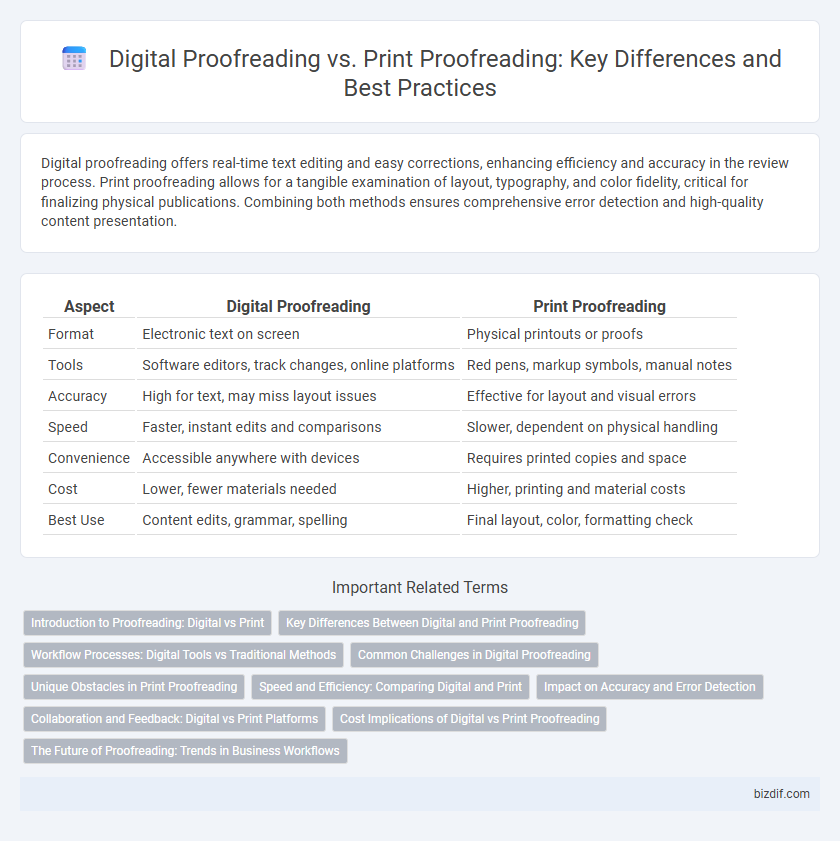Digital proofreading offers real-time text editing and easy corrections, enhancing efficiency and accuracy in the review process. Print proofreading allows for a tangible examination of layout, typography, and color fidelity, critical for finalizing physical publications. Combining both methods ensures comprehensive error detection and high-quality content presentation.
Table of Comparison
| Aspect | Digital Proofreading | Print Proofreading |
|---|---|---|
| Format | Electronic text on screen | Physical printouts or proofs |
| Tools | Software editors, track changes, online platforms | Red pens, markup symbols, manual notes |
| Accuracy | High for text, may miss layout issues | Effective for layout and visual errors |
| Speed | Faster, instant edits and comparisons | Slower, dependent on physical handling |
| Convenience | Accessible anywhere with devices | Requires printed copies and space |
| Cost | Lower, fewer materials needed | Higher, printing and material costs |
| Best Use | Content edits, grammar, spelling | Final layout, color, formatting check |
Introduction to Proofreading: Digital vs Print
Digital proofreading leverages software tools to identify spelling, grammar, and formatting errors swiftly, making it ideal for online content and fast-paced workflows. Print proofreading involves meticulous manual review of physical documents to catch layout inconsistencies, typographical errors, and color inaccuracies that digital tools might miss. Combining both approaches enhances overall accuracy and ensures polished final outputs for diverse publishing mediums.
Key Differences Between Digital and Print Proofreading
Digital proofreading allows for real-time text editing and immediate feedback through software tools, enhancing efficiency and accuracy. Print proofreading requires physical copies, emphasizing manual markup with traditional proofreading marks to identify errors on paper. The key difference lies in the medium of review, where digital proofs facilitate faster revisions and print proofs provide a tangible reference for final corrections.
Workflow Processes: Digital Tools vs Traditional Methods
Digital proofreading leverages advanced software tools like track changes and automated grammar checkers to streamline error detection and revision workflows, significantly reducing turnaround time. Traditional print proofreading relies on manual markups and physical proofs, which can be time-consuming and prone to human error but offers tactile interaction with the material. Integrating digital tools into the workflow enhances collaboration and accuracy while traditional methods remain valuable for final quality assurance in print production.
Common Challenges in Digital Proofreading
Digital proofreading often encounters challenges such as screen fatigue, which can reduce accuracy and increase the likelihood of missed errors compared to print proofreading. Variations in screen resolution, font rendering, and color display may distort the appearance of text, making it harder to identify formatting issues and subtle typographical mistakes. File compatibility issues and version control errors frequently disrupt digital workflows, complicating the correction and approval process.
Unique Obstacles in Print Proofreading
Print proofreading presents unique obstacles such as the challenge of detecting color inconsistencies and registration errors that are often invisible on digital screens. Physical proofs require careful handling to avoid damage while thoroughly checking for issues like paper quality, ink density, and layout alignment. These tactile and visual nuances demand specialized skills that differ significantly from digital proofreading processes.
Speed and Efficiency: Comparing Digital and Print
Digital proofreading dramatically enhances speed and efficiency by allowing instant text edits and automated error detection, reducing the time spent on manual review. Print proofreading, while offering a tactile and visually comprehensive approach, typically slows the process due to physical handling and the need for multiple print iterations. The integration of digital tools streamlines workflow, making digital proofreading the preferred choice for fast-paced publishing environments.
Impact on Accuracy and Error Detection
Digital proofreading leverages advanced software tools like AI-based grammar checkers and spellcheckers to enhance accuracy and detect errors efficiently in real-time, reducing human oversight. Print proofreading allows for tactile inspection of physical documents, which can reveal formatting issues, color inconsistencies, and layout errors that digital previews may miss. Combining both digital and print proofreading processes significantly improves the overall error detection rate and ensures higher accuracy in the final publication.
Collaboration and Feedback: Digital vs Print Platforms
Digital proofreading platforms enable real-time collaboration and instant feedback, streamlining the editing process and reducing turnaround times. Print proofreading relies on physical markups, which can slow communication and increase the risk of misinterpretation during feedback exchanges. Digital tools also offer version control and comment tracking, enhancing transparency and accountability among collaborators compared to traditional print methods.
Cost Implications of Digital vs Print Proofreading
Digital proofreading significantly reduces costs by eliminating expenses related to printing materials, physical distribution, and manual labor for handling hard copies. Print proofreading incurs higher costs due to the need for producing multiple physical proofs, which entails paper, ink, and shipping fees. Companies often save up to 60% on proofreading expenses by transitioning from print to digital workflows, making digital methods more budget-friendly and scalable.
The Future of Proofreading: Trends in Business Workflows
Digital proofreading leverages AI-powered tools and real-time collaboration platforms, significantly enhancing accuracy and efficiency in business workflows. Print proofreading remains essential for physical publications but is increasingly integrated with digital processes to streamline error detection and corrections. Emerging trends emphasize hybrid systems that combine digital speed with the tactile benefits of print, driving innovation in proofreading for future business environments.
Digital Proofreading vs Print Proofreading Infographic

 bizdif.com
bizdif.com